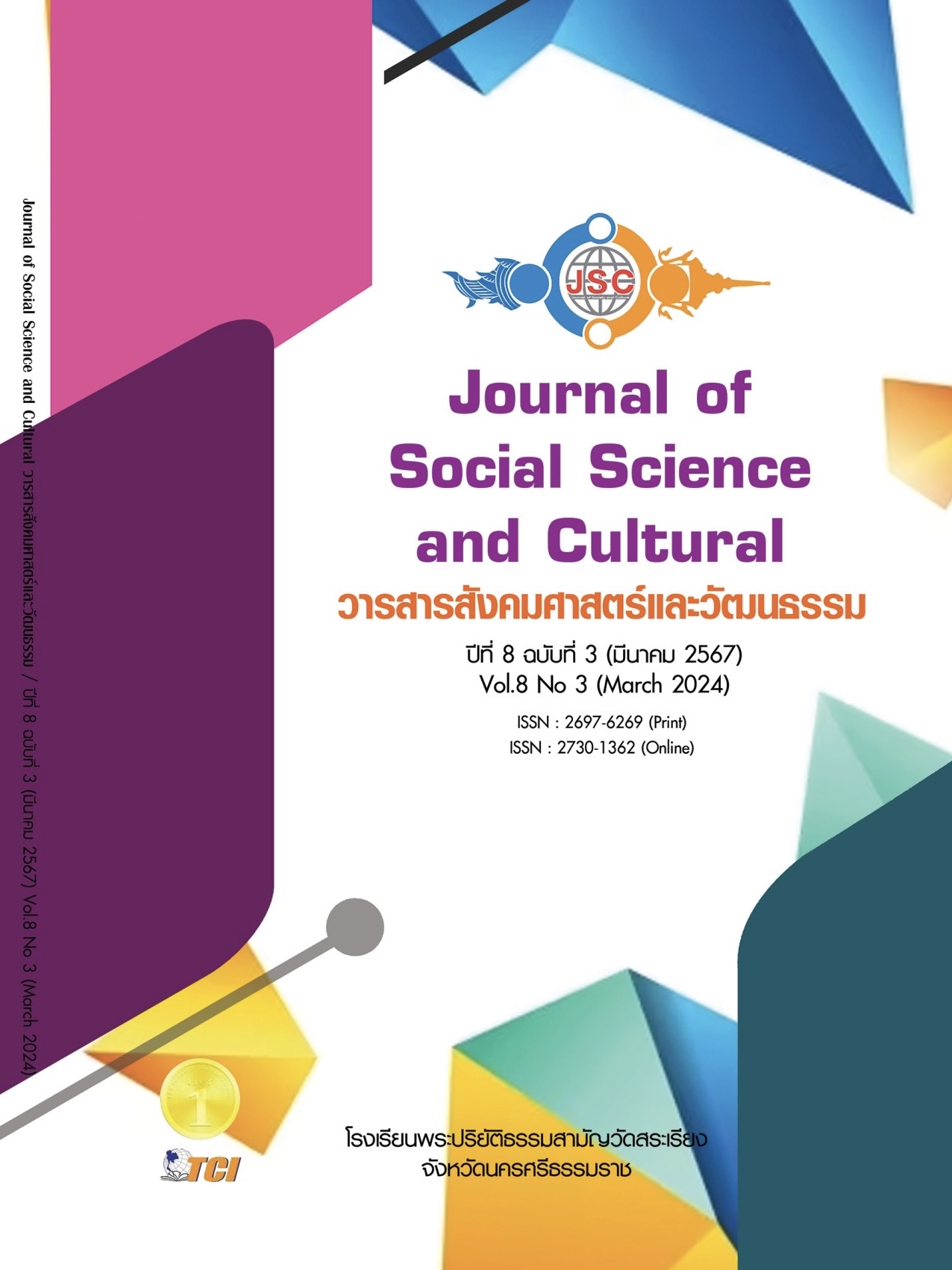THE DEVELOPMENT OF EXTRA-CURRICULAR GAME ACTIVITY IN MATHEMATICS ON ADDING, SUBTRACTING, MULTIPLYING AND DIVIDING BETWEEN STUDENTS IN PRATHOM SUKSA 4 THE EDUCATIONAL INSTITUTION SALES NETWORK BAN PHRU PHATONG
Main Article Content
Abstract
This research aimed to 1) develop an extracurricular game on addition, subtraction, multiplication, and division for the fourth-grade students from network schools of Ban Phru Phatong based on the 80/80 criteria. 2) develop a manual of the extracurricular game on addition, subtraction, multiplication, and division for the fourth-grade students from network schools of Ban Phru Phatong, and 3) compare mathematics learning achievement between students who use the extracurricular game and those who do not for the fourth-grade students from network schools of Ban Phru Phatong, using an experimental research methodology. The population is the fourth-grade students in the second semester of the academic year 2023 from network schools in Ban Phru Phatong. The sample group was the fourth-grade students of Ban Pho Mo School (Phrom Thep Ratch Bum Rung), using simple random sampling by the lottery method through the school as the random unit. The research instruments used were a code math game, a manual of extracurricular games on addition, subtraction, multiplication, and division, a learning management plan, and the learning achievement tests. The statistics used in data analysis are the means, standard deviation, and means comparison of two independent groups. The research found that 1) the extracurricular game was a coding game, decoding the message by using knowledge of mathematical operations regarding addition, subtraction, multiplication, and division, divided into 3 levels, which are addition and subtraction level, multiplication and division level, and addition, subtraction, multiplication and division level. The efficiency value of the extracurricular game was 81.17/81.33, 2) the manual of the extracurricular game consists of methods of use, learning objectives, explanations, during-class and after-class exercises, and review exercises, and 3) the learning achievement in mathematics of students who use the extracurricular game is higher than that of students who do not use the extracurricular game statistically significant at .01.
Article Details
References
กระทรวงศึกษาธิการ. (2560). หลักสูตรแกนกลางการศึกษาขั้นพื้นฐาน พุทธศักราช 2551 และมาตรฐานการเรียนรู้และตัวชี้วัดฯ (ฉบับปรับปรุง พ.ศ. 2560). (พิมพ์ครั้งที่ 1). กรุงเทพมหานคร: โรงพิมพ์ชุมนุมสหกรณ์การเกษตรแห่งประเทศไทย จำกัด.
กานต์ธีรา ภูริวิกรัย. (2564). การศึกษาโลกในศตวรรษที่ 21: ระบบยังเหลื่อมล้ำ การเรียนรู้ยังวิกฤต. เรียกใช้เมื่อ 1 ตุลาคม 2562 จาก https://www.eef.or.th/global-education/
จักรเพชร สุริระกมล. (2559). ผลของการจัดกิจกรรมเสริมหลักสูตรแบบบูรณาการตามแนวคิดสะเต็มศึกษาที่มีต่อการรู้เท่าทันและพฤติกรรมการแก้ปัญหาแบบร่วมมือ ของนักเรียนชั้นประถมศึกษาปีที่6. ใน วิทยานิพนธ์ดุษฎีบัณฑิต สาขาวิชาการวิจัยพฤติกรรมศาสตร์ประยุกต์. มหาวิทยาลัยศรีนครินทรวิโรฒ.
เฉลิมวุฒิ คำเมือง. (2566). คณิตศาสตร์ในศตวรรษที่ 21 Mathematics in the 21st Century. เรียกใช้เมื่อ 1 มกราคม 2567 จาก https://math.bru.ac.th/คณิตศาสตร์ในศตวรรษที่-21-mathema/
ชมพูนุษ์ บุญทศ. (2562). การพัฒนาเกมคอมพิวเตอร์ด้วยการเรียนรู้เชิงรุก เรื่องการเขียนโปรแกรมเบื้องต้นสำหรับนักเรียนชั้นประถมศึกษาปีที่ 1. ใน วิทยานิพนธ์มหาบัณฑิต สาขาวิชาเทคโนโลยีและสื่อสารการศึกษา. มหาวิทยาลัยเทคโนโลยีราชมงคลธัญบุรี .
ชูศักดิ์ วรุณกูล. (2538). กิจกรรมเสริมหลักสูตร. เชียงใหม่: ภาควิชาหลักสูตรและการสอน คณะครุศาสตร์ - สถาบันราชภัฏเชียงใหม่.
พล เหลืองรังษี. (2564). การวิจัยเพื่อพัฒนาการเรียนรู้. (พิมพ์ครั้งที่3). กรุงเทพมหาคร: สหมิตรพัฒนาการพิมพ์.
พิมพ์ชนก ค้ำชู. (2555). การจัดกิจกรรมเสริมหลักสูตรตามแนวทางคาร์ล ออร์ฟ เพื่อพัฒนาทักษะในรายวิชาดนตรี - นาฏศิลป์ ของนักเรียนชั้นประถมศึกษา. ใน วิทยานิพนธ์มหาบัณฑิต สาขาวิชาเทคโนโลยีการวิจัยและพัฒนาหลักสูตร. มหาวิทยาลัยเทคโนโลยีราชมงคลธัญบุรี.
ลดาวัลย์ แย้มครวญ และศุภกฤษฏิ์ นิวัฒนากูล. (2560). การออกแบบและพัฒนาเกมเพื่อการเรียนรู้สาหรับวิชาคณิตศาสตร์ ชั้นประถมศึกษาปีที่ 6. ใน วิทยานิพนธ์มหาบัณฑิต สาขาวิชาเทคโนโลยีสารสนเทศ. มหาวิทยาลัยเทคโนโลยีสุรนารี.
วิชัย พาณิชย์สวย. (2560). หัวใจของการสอนคณิตศาสตร์ระดับประถมศึกษา. เรียกใช้เมื่อ 25 กุมภาพันธ์ 2567 จาก http://www.pecerathailand.org/2017/03/2009.html
วิโรจน์ เฉลยสุข. (2564). การพัฒนาชุดกิจกรรมเสริมหลักสูตรเพื่อเสริมสร้างจิตสาธารณะของนักเรียน ระดับชั้นมัธยมศึกษาตอนปลาย ในโรงเรียนสังกัดสำนักงานเขตพื้นที่การศึกษา มัธยมศึกษาสกลนคร. วิทยานิพนธ์ดุษฎีบัณฑิต สาขาวิชาการบริหารและพัฒนาการศึกษา: มหาวิทยาลัยราชภัฏสกลนคร.
สถาบันทดสอบทางการศึกษาแห่งชาติ (องค์การมหาชน). (2565). สรุปผลการทดสอบทางการศึกษาแห่งชาติขั้นพื้นฐาน (NT). เรียกใช้เมื่อ 25 ตุลาคม 2567 จาก http://180.180.244.42/NT/ExamWeb/FrLogin. aspx?ReturnUrl=%2fNT
สินชัย จันทร์เสม และเอมมิกา วชิระวินท์. (2564). การใช้กิจกรรมเสริมคณิตศาสตร์แบบเชื่อมโยงบริบทเพื่อพัฒนาความสามารถในการแก้ปัญหาคณิตศาสตร์และเจตคติต่อวิชาคณิตศาสตร์ของนักเรียนระดับประถมศึกษาตอนปลาย. วารสารวิจัยทางการศึกษา, 16(1), 108-109.
สุวิทย์ มูลคำ และอรทัย มูลคำ. (2545). วิธีจัดการเรียนรู้. (พิมพ์ครั้งที่ 7). กรุงเทพมหานคร: โรงพิมพ์ภาพพิมพ์.
เอกพรต สมุทธานนท์. (2556). การเขียนคู่มือครู GotoKnow. เรียกใช้เมื่อ 2 ตุลาคม 2567 จาก https://www. gotoknow.org/posts/235436
McNeal, R. B. (2010). High School Extracurricular Activities: Closed Structures and Stratifying Patterns of Participation. The Journal of Educational Research, 91(3), 183-191.


